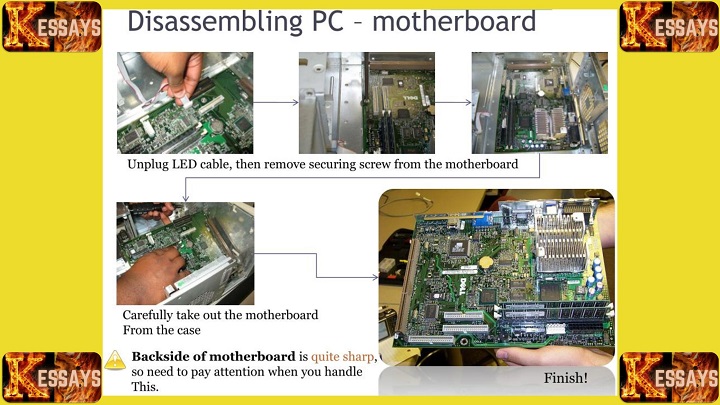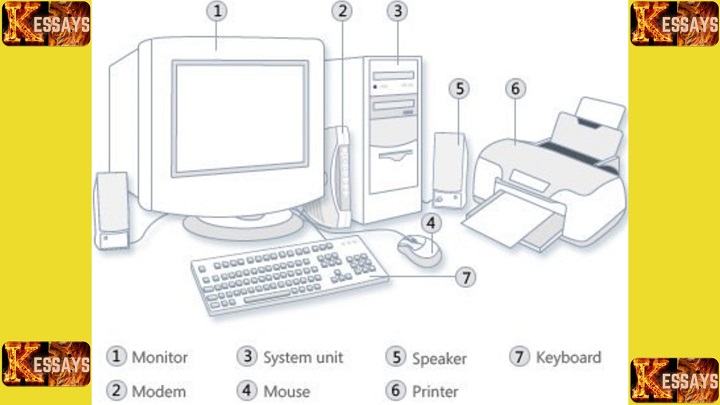Introduction
The realm of technology is underpinned by a foundational layer known as system software. This software acts as the bedrock upon which applications and user interactions are built. This essay delves into the multifaceted world of system software, its significance, components, and its role in shaping the digital landscape.
Foundational Layer:
The world of technology finds its base in a critical layer known as system software.
- Essential Infrastructure: System software forms the indispensable infrastructure that supports and facilitates the entire technological landscape.
- Underpinning Technology: It serves as the underlying framework upon which all other software and applications are built.
- Structural Integrity: Just as a building's foundation ensures stability, system software ensures the stability and functionality of the entire digital ecosystem.
- Bridge Between Hardware and Software: System software acts as a bridge connecting the hardware components of a computer to the software applications that run on it.
- Enabler of Functionality: It empowers hardware to perform specific tasks and enables applications to access resources efficiently.

Bedrock for Applications:
- Nurturing Applications: System software provides the nurturing ground on which applications flourish and cater to users' needs.
- Vital Support Structure: It serves as the vital support structure that empowers applications to function seamlessly and deliver desired outcomes.
- Interaction Facilitator: System software acts as the mediator that enables smooth interactions between users and applications.
- User-Centric Foundation: Applications derive their usability and efficiency from the solid foundation established by the system software.
Exploring the Multifaceted:
- Complex and Intricate: The realm of system software is marked by its intricate nature, encompassing various components and functionalities.
- Diverse Aspects: From operating systems to device drivers, system software covers a diverse range of elements that collectively contribute to its complexity.
- Underlying Complexity: This exploration delves into the underlying complexities that make system software a dynamic and multifaceted domain.
Significance Unveiled:
- Unearthing Importance: The essay's objective is to unveil the significance of system software that often operates behind the scenes but plays a crucial role.
- Component Breakdown: The essay seeks to break down the components of system software and highlight their individual and collective importance.
- Shaping the Digital Era: By delving into its role, the essay aims to showcase how system software plays a profound role in shaping the modern digital landscape.
Understanding System Software
Essential Foundation:
- Bridging Hardware and Software: System software acts as a pivotal bridge that connects the physical hardware components to the realm of application software.
- Harmonizing Elements: It ensures seamless communication between hardware and software, harmonizing their interactions for efficient functionality.
- Intermediary Role: By serving as an intermediary, system software enables hardware and applications to collaborate effectively.
Infrastructure Provider:
- Crucial Framework: The framework established by system software is indispensable for efficiently managing and controlling hardware resources.
- Resource Optimization: It ensures optimal allocation of resources such as CPU, memory, and storage, contributing to smoother application execution.
- Enhancing User Experience: By providing a stable environment, system software enhances user experiences while interacting with applications.
Operating Systems:
- Resource Management: Operating systems proficiently manage hardware resources, ensuring their efficient utilization by applications.
- Communication Facilitator: They act as facilitators for communication between software and hardware components, enabling smooth interactions.
- User Interface: Operating systems provide a user-friendly interface, making technology accessible to users with diverse levels of technical knowledge.
Device Drivers:
- Hardware Intermediaries: Device drivers serve as intermediaries that enable effective communication between hardware devices and the operating system.
- Enabling Functionality: They allow hardware components to function cohesively within the software ecosystem, enabling their intended features.
- Enhanced Hardware Compatibility: Device drivers ensure that diverse hardware devices can seamlessly integrate into the system.
Utilities:
- Maintenance and Optimization: System software includes utilities designed to manage and maintain various aspects of the computer system.
- Data Integrity: Utilities for tasks like data backup and recovery ensure the integrity and safety of user data.
- System Performance: Optimizing utilities enhance system performance, ensuring efficient utilization of resources over time.
Each aspect of system software contributes to a harmonious digital environment, where hardware, software, and user interactions seamlessly converge for optimal outcomes.
My Reflection about System Software
Pivotal Role Acknowledged:
- Central Pillar of Functionality: Upon reflecting on system software, its undeniable centrality within the digital ecosystem becomes strikingly apparent.
- Indispensable Backbone: The recognition of its role as an indispensable backbone underscores how it ensures the smooth functioning of all digital interactions.
- Ecosystem Sustenance: It functions as the essential glue that holds together the intricate web of hardware, software, and user interactions.
Bridging the Gap:
- Harmony in Interactions: My reflection has highlighted how system software plays the pivotal role of a bridge, harmonizing the seemingly disparate worlds of hardware and a vast array of applications.
- Seamless Interplay: This understanding reveals how it enables the seamless interaction between physical components and the digital experiences users encounter.
- Efficiency Amplified: By serving as this bridge, system software amplifies the efficiency and effectiveness of technology-enabled activities.
Enhanced Appreciation:
- Unveiling the Unsung Heroes: Delving into system software has unveiled the unsung heroes behind our technological experiences.
- Smooth Operator: Understanding the significance of operating systems and device drivers has bestowed a newfound reverence for the unnoticeable yet crucial elements that ensure technology operates seamlessly.
- A Fresh Perspective: This recognition provides a fresh lens through which to view the technology we often take for granted, showcasing the intricacies that facilitate its seemingly effortless operation.
Impact of Utilities:
- Behind-the-Scenes Guardians: My reflection has brought to light the often-overlooked guardians of system health and performance—utilities.
- Safeguarding the System: The insight into their role in maintaining performance, optimizing resources, and safeguarding data has revealed their crucial contribution to the longevity and reliability of our digital devices.
- Sustainable Technology Experiences: By highlighting their impact, my reflection underscores the role utilities play in ensuring sustainable and consistent technology experiences over time.
In summary, my reflection on system software has provided a comprehensive understanding of its multifaceted nature and its integral position within the digital landscape. The acknowledgment of its pivotal role, its function as a bridge, and the significance of its components collectively weave a tapestry that underscores the seamless and dynamic nature of technology-enabled interactions.

Importance of System Software
Resource Management:
- Optimized Resource Allocation: System software serves as a proficient manager, allocating resources like CPU, memory, and storage optimally.
- Efficiency Amplification: By ensuring efficient resource utilization, it enhances the overall system performance and responsiveness.
- Seamless Workload Handling: Proper resource management prevents resource bottlenecks and ensures that multiple tasks can be executed simultaneously without hindrance.
Security Enhancements:
- Guardians of Data: Security features integrated into system software form a robust defense against malicious attacks and potential data breaches.
- Data Confidentiality and Integrity: These features safeguard sensitive information, ensuring that user data remains confidential and unaltered.
- Vigilant Protection: By monitoring and responding to threats, system software maintains the security posture of the entire digital environment.
User Interface:
- User-Centric Design: Operating systems, a key facet of system software, present users with a friendly and intuitive interface.
- Accessible Interaction: The user interface acts as a gateway, making technology accessible to users with varying levels of technical expertise.
- Seamless Interaction: It ensures that users can interact with their devices and applications in a way that feels natural and effortless.
Compatibility:
- Harmonizing Diverse Hardware: System software plays a pivotal role in ensuring that applications are compatible with a wide range of hardware configurations.
- Unified Experience: Regardless of the specific hardware setup, system software enables applications to run consistently and smoothly.
- Reduced Fragmentation: This compatibility reduces the fragmentation of technology experiences, fostering a cohesive digital ecosystem.
Stability and Reliability:
- Foundation of Dependability: A well-designed system software lays the foundation for a stable and reliable computing environment.
- Resilient Performance: It minimizes crashes, freezes, and unexpected errors, ensuring a consistent and dependable user experience.
- Confidence in Operations: A stable system instills confidence in users, as they can rely on their technology to perform as expected.
In essence, the importance of system software is deeply woven into the fabric of the digital landscape. Its ability to efficiently manage resources, provide security, enable user-friendly interactions, ensure compatibility, and deliver stability and reliability serves as the backbone that sustains the entire technological ecosystem.
Components of System Software
Operating Systems:
- Resource Management and Allocation: Operating systems (OSes) are the heart of system software, efficiently managing and allocating hardware resources like CPU, memory, and storage.
- Multitasking Facilitators: OSes enable multitasking, allowing multiple applications to run concurrently without conflicts.
- Application Platform: They provide a platform upon which applications can be developed, executed, and interacted with.
- User Interface Framework: Operating systems offer user interfaces that allow users to interact with the computer and its applications.
Device Drivers:
- Hardware-Software Intermediaries: Device drivers act as crucial intermediaries, facilitating communication between hardware devices and the operating system.
- Ensuring Device Functionality: They ensure that hardware components can seamlessly interact with the system, enabling their intended functionalities.
- Efficiency Optimization: Device drivers optimize the utilization of hardware resources and ensure they work harmoniously with the operating system.
Firmware:
- Embedded Control: Firmware represents embedded software that controls specific operations of hardware devices.
- Hardware-Specific Functions: It contains code that directs hardware components to perform their designated functions.
- Stability and Consistency: Firmware ensures that hardware devices function reliably and consistently according to their designed capabilities.
Utilities:
- Maintenance and Management: Utilities form a diverse set of tools aimed at maintaining the system's health and performance.
- Data Protection and Recovery: Utilities include functionalities such as data backup, recovery, and protection against threats like viruses and malware.
- Enhancing Efficiency: Utilities like disk defragmentation optimize storage, enhancing the overall efficiency and longevity of the system.
These components collectively compose the intricate framework of system software, playing distinct but interconnected roles in ensuring the efficient and reliable operation of the entire digital environment.
Role in Shaping the Digital Landscape
Enabling Applications:
- Foundation for Functionality: System software lays the foundation upon which a diverse array of applications can thrive.
- Application Ecosystem: From essential productivity tools to captivating entertainment software, all applications find their operational base in the system software.
- Execution Platform: It provides the necessary environment for applications to execute their functions seamlessly and efficiently.
Innovation Catalyst:
- Cultivating Innovation: Advances in system software act as catalysts, fostering innovation by enabling the development of new functionalities and features.
- Enhanced User Experiences: Innovations in system software lead to improved user experiences through smoother interactions, enhanced visuals, and more intuitive interfaces.
- Fueling Technological Evolution: Innovations ripple through the entire technological ecosystem, driving progress across various sectors.
Connectivity and Networking:
- Enabling Global Connections: System software plays a pivotal role in facilitating network connections, enabling devices to connect to each other and to the internet.
- Internet Access: It empowers users to access online resources, communicate globally, and tap into the vast pool of digital information.
- Seamless Data Flow: System software ensures that data can be transmitted, received, and processed across interconnected devices.
Security and Privacy:
- Data Safeguarding: Security features embedded in system software are guardians of sensitive data, safeguarding it from potential threats.
- Threat Mitigation: System software takes proactive measures to detect and counteract various forms of cyber threats, ensuring the system's integrity.
- User Privacy: By incorporating security measures, it respects and upholds user privacy, safeguarding personal information from unauthorized access.
In summary, the multifaceted role of system software in shaping the digital landscape cannot be overstated. It acts as a platform for applications, a catalyst for innovation, a facilitator of connectivity, and a shield against threats. By enabling seamless interactions, fostering progress, enabling global connections, and ensuring security, system software remains a cornerstone of modern technological advancement.

Conclusion
In conclusion, system software serves as the unsung hero of the digital age, enabling seamless interactions between hardware and software. Its role in resource management, security, and user experience cannot be overstated. My reflection about system software has illuminated its intricacies and significance, underscoring its indispensable role in shaping the dynamic digital landscape. As technology continues to evolve, the importance of robust and innovative system software remains unwavering.


